Abstract
Club foot is one of the most common human congenital malformations. Distal arthrogryposis type I (DA-1) is a frequent cause of dominantly inherited club foot. Performing a genomewide search using short tandem repeat (STR) polymorphisms, we have mapped a DA-1 gene to the pericentromeric region of chromosome 9 in a large kindred. Linkage analysis has generated a positive lod score of 5.90 at theta = 0, with the marker GS-4. Multiple recombinants bracketing the region have been identified. Analysis of an additional family demonstrated no linkage to the same locus, indicating likely locus heterogeneity. Of the autosomal congenital contracture disorders causing positional foot deformities, this is the first to be mapped.
Full text
PDF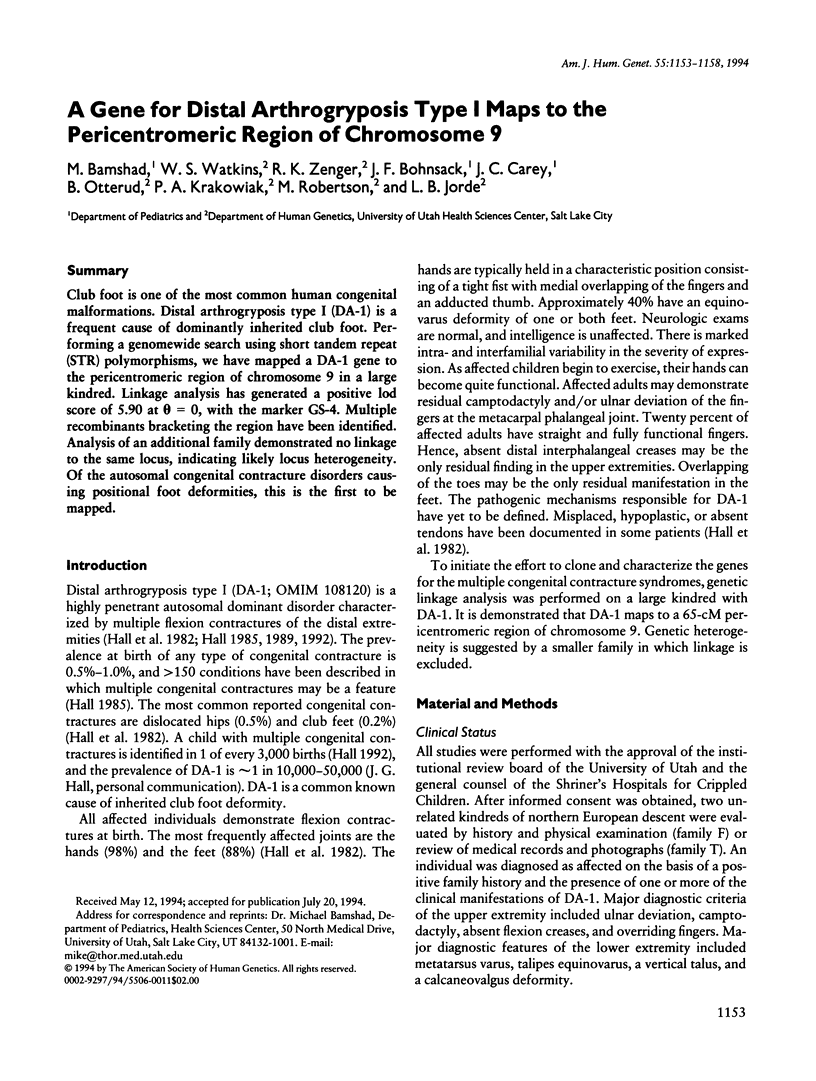
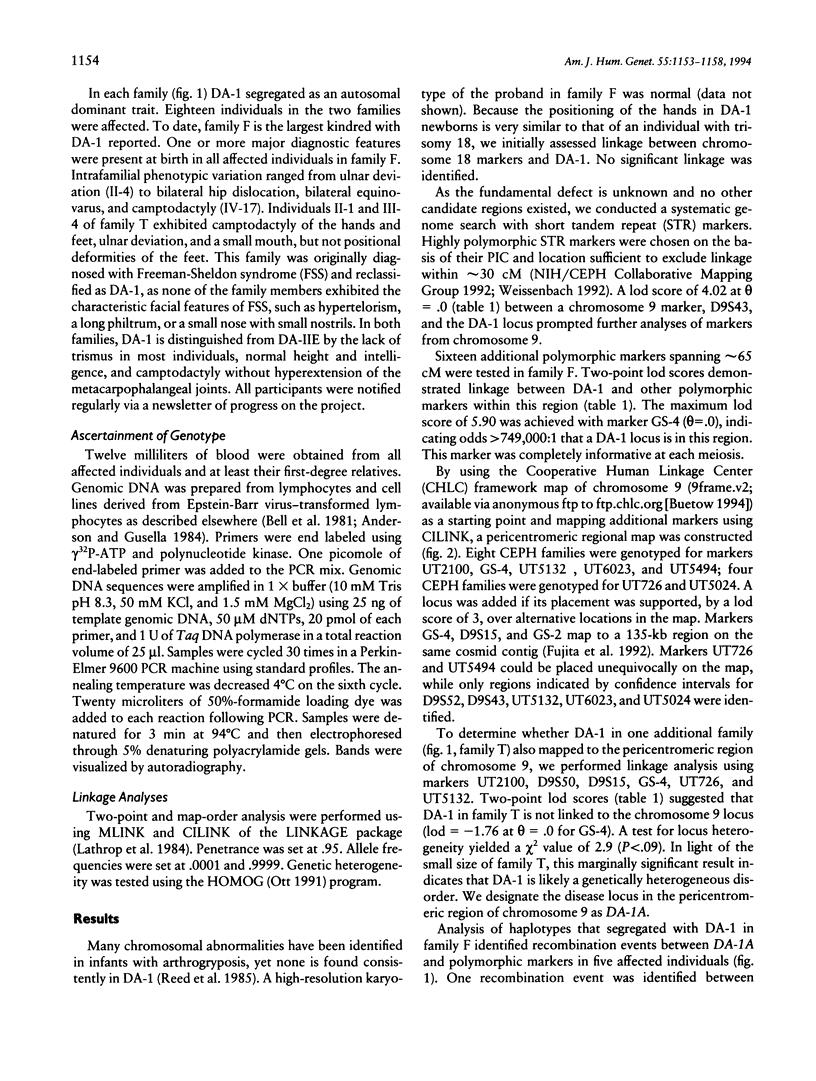
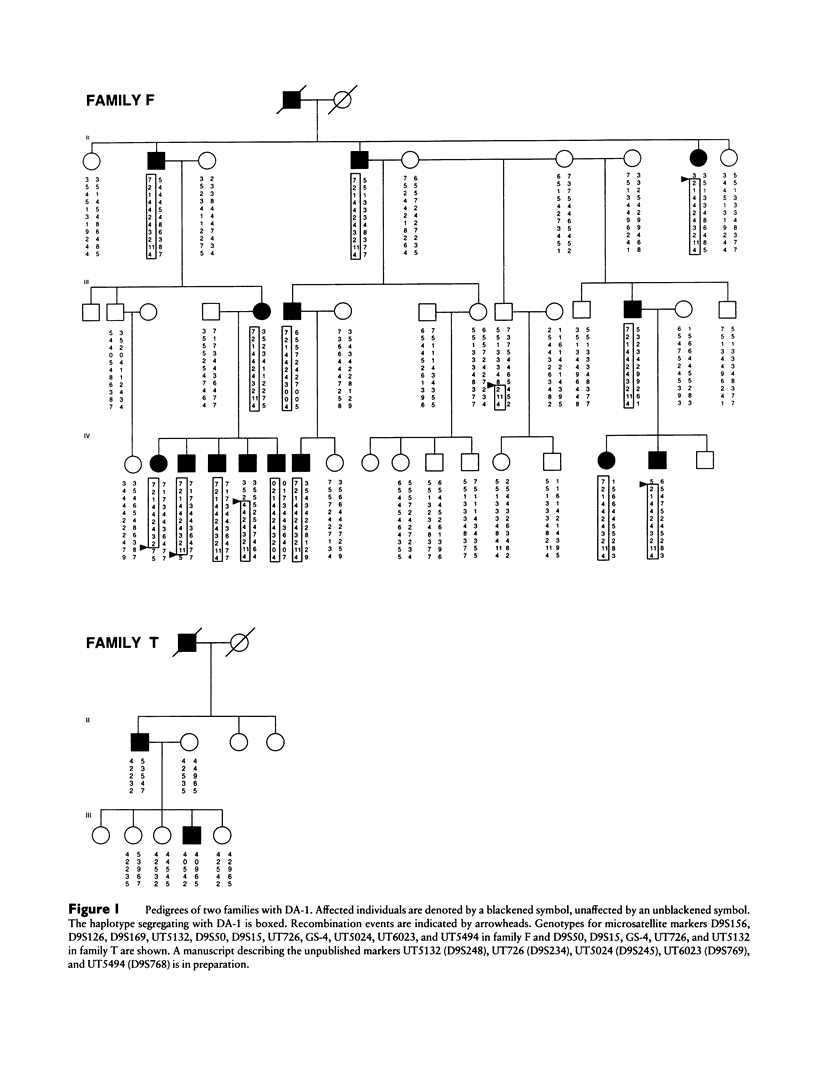
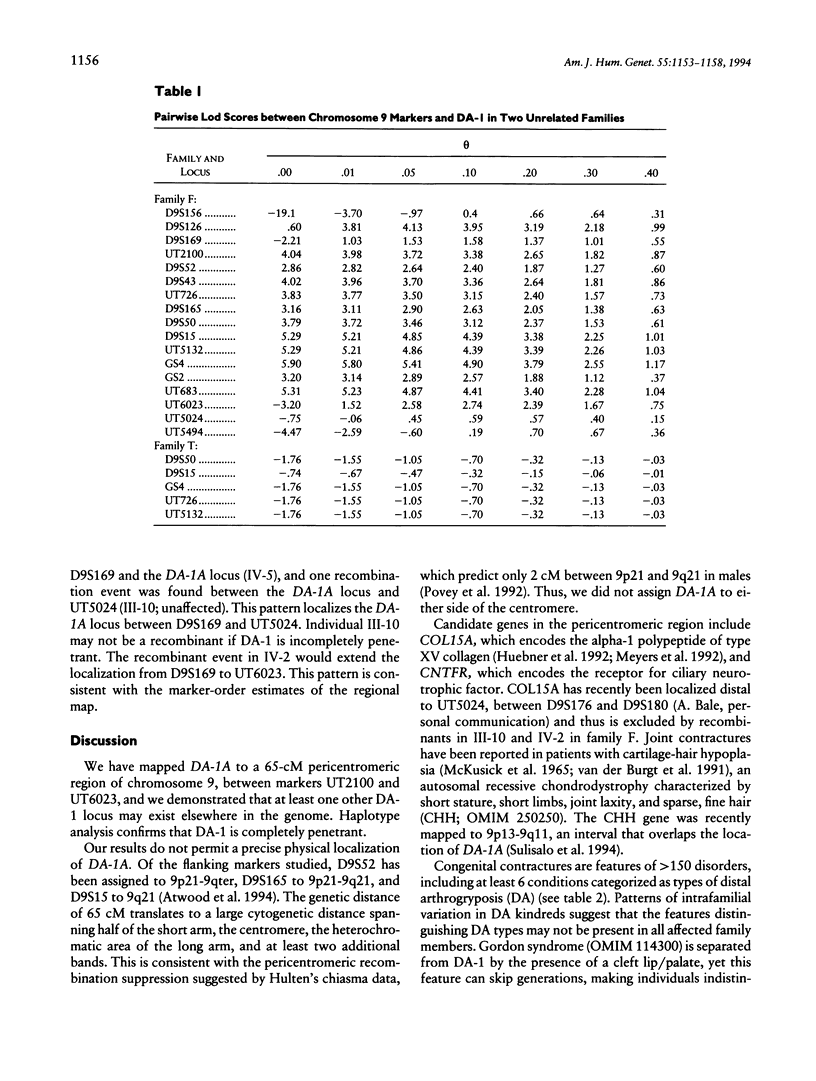
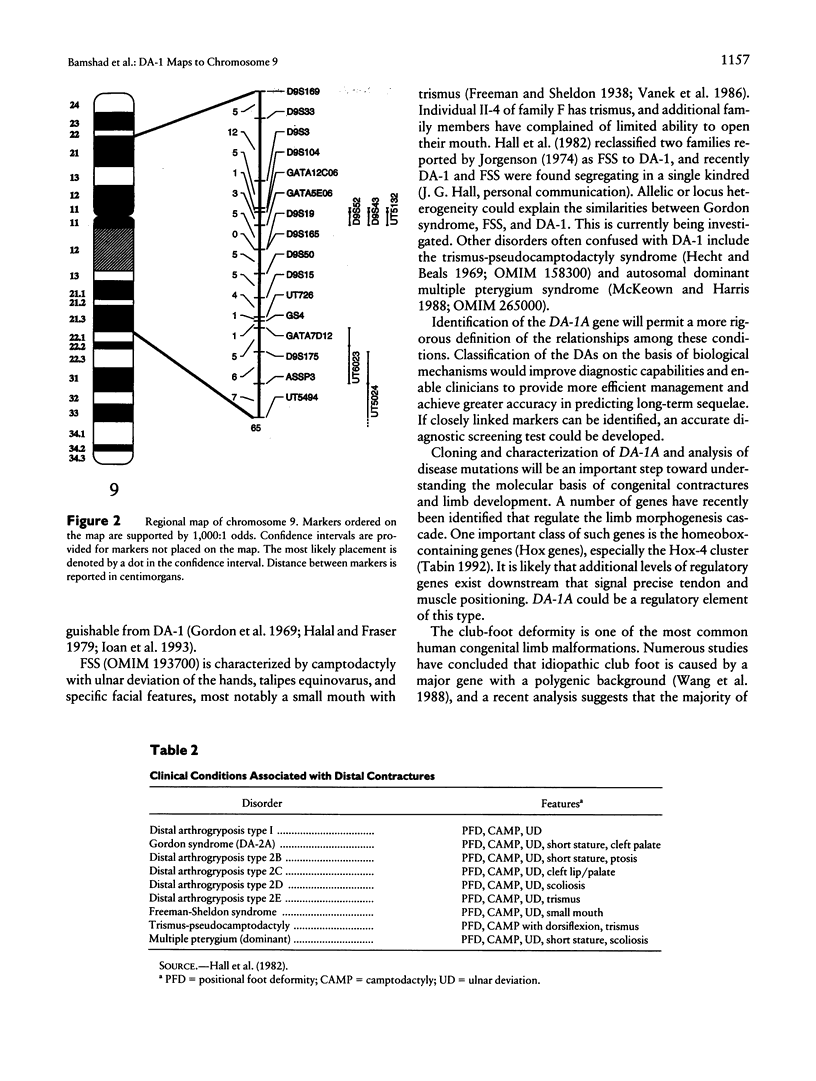
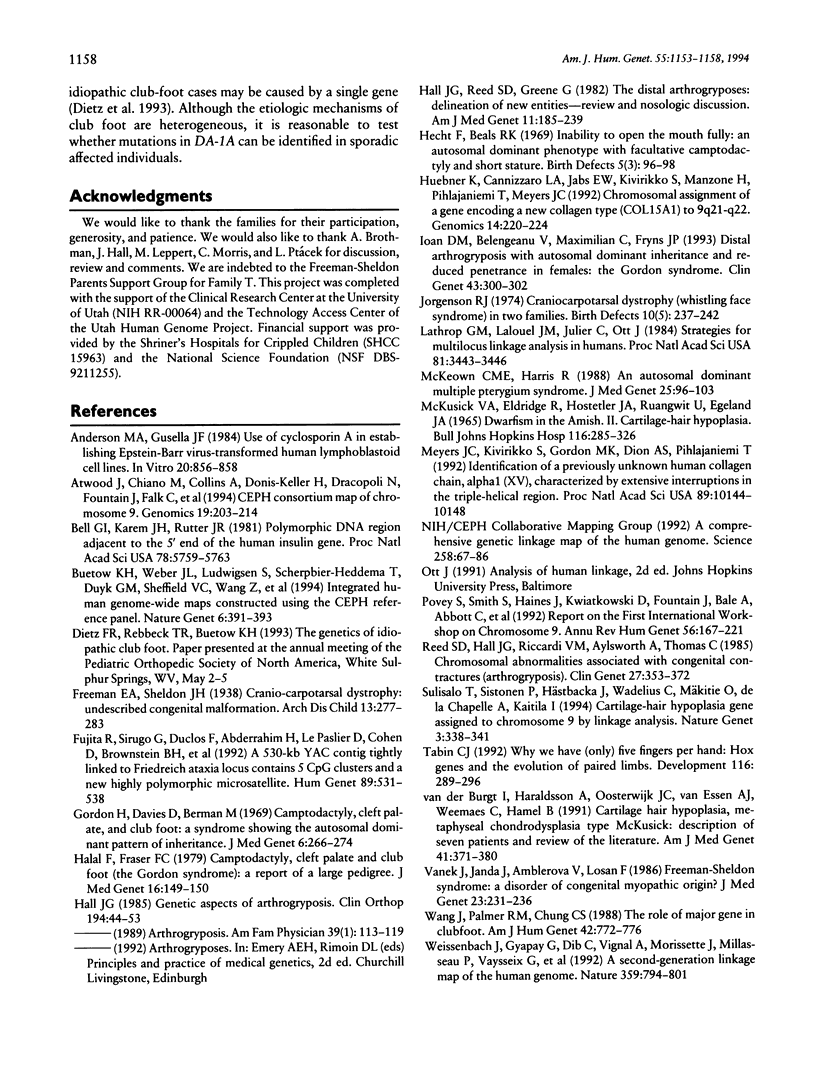
Selected References
These references are in PubMed. This may not be the complete list of references from this article.
- Anderson M. A., Gusella J. F. Use of cyclosporin A in establishing Epstein-Barr virus-transformed human lymphoblastoid cell lines. In Vitro. 1984 Nov;20(11):856–858. doi: 10.1007/BF02619631. [DOI] [PubMed] [Google Scholar]
- Attwood J., Chiano M., Collins A., Donis-Keller H., Dracopoli N., Fountain J., Falk C., Goudie D., Gusella J., Haines J. CEPH consortium Map of chromosome 9. Genomics. 1994 Jan 15;19(2):203–214. doi: 10.1006/geno.1994.1049. [DOI] [PubMed] [Google Scholar]
- Bell G. I., Karam J. H., Rutter W. J. Polymorphic DNA region adjacent to the 5' end of the human insulin gene. Proc Natl Acad Sci U S A. 1981 Sep;78(9):5759–5763. doi: 10.1073/pnas.78.9.5759. [DOI] [PMC free article] [PubMed] [Google Scholar]
- Buetow K. H., Weber J. L., Ludwigsen S., Scherpbier-Heddema T., Duyk G. M., Sheffield V. C., Wang Z., Murray J. C. Integrated human genome-wide maps constructed using the CEPH reference panel. Nat Genet. 1994 Apr;6(4):391–393. doi: 10.1038/ng0494-391. [DOI] [PubMed] [Google Scholar]
- Fujita R., Sirugo G., Duclos F., Abderrahim H., Le Paslier D., Cohen D., Brownstein B. H., Schlessinger D., Mandel J. L., Koenig M. A 530kb YAC contig tightly linked to the Friedreich ataxia locus contains five CpG clusters and a new highly polymorphic microsatellite. Hum Genet. 1992 Jul;89(5):531–538. doi: 10.1007/BF00219179. [DOI] [PubMed] [Google Scholar]
- Gordon H., Davies D., Berman M. Camptodactyly, cleft palate, and club foot. A syndrome showing the autosomal-dominant pattern of inheritance. J Med Genet. 1969 Sep;6(3):266–274. doi: 10.1136/jmg.6.3.266. [DOI] [PMC free article] [PubMed] [Google Scholar]
- Halal F., Fraser F. C. Camptodactyly, cleft palate, and club foot (the Gordon syndrome). A report of a large pedigree. J Med Genet. 1979 Apr;16(2):149–150. doi: 10.1136/jmg.16.2.149. [DOI] [PMC free article] [PubMed] [Google Scholar]
- Hall J. G. Genetic aspects of arthrogryposis. Clin Orthop Relat Res. 1985 Apr;(194):44–53. [PubMed] [Google Scholar]
- Hall J. G., Reed S. D., Greene G. The distal arthrogryposes: delineation of new entities--review and nosologic discussion. Am J Med Genet. 1982 Feb;11(2):185–239. doi: 10.1002/ajmg.1320110208. [DOI] [PubMed] [Google Scholar]
- Huebner K., Cannizzaro L. A., Jabs E. W., Kivirikko S., Manzone H., Pihlajaniemi T., Myers J. C. Chromosomal assignment of a gene encoding a new collagen type (COL15A1) to 9q21 --> q22. Genomics. 1992 Oct;14(2):220–224. doi: 10.1016/s0888-7543(05)80209-5. [DOI] [PubMed] [Google Scholar]
- Ioan D. M., Belengeanu V., Maximilian C., Fryns J. P. Distal arthrogryposis with autosomal dominant inheritance and reduced penetrance in females: the Gordon syndrome. Clin Genet. 1993 Jun;43(6):300–302. doi: 10.1111/j.1399-0004.1993.tb03822.x. [DOI] [PubMed] [Google Scholar]
- Jorgenson R. J. M--craniocarpotarsal dystrophy (whistling face syndrome) in two families. Birth Defects Orig Artic Ser. 1974;10(5):237–242. [PubMed] [Google Scholar]
- Lathrop G. M., Lalouel J. M., Julier C., Ott J. Strategies for multilocus linkage analysis in humans. Proc Natl Acad Sci U S A. 1984 Jun;81(11):3443–3446. doi: 10.1073/pnas.81.11.3443. [DOI] [PMC free article] [PubMed] [Google Scholar]
- MCKUSICK V. A., ELDRIDGE R., HOSTETLER J. A., RUANGWIT U., EGELAND J. A. DWARFISM IN THE AMISH. II. CARTILAGE-HAIR HYPOPLASIA. Bull Johns Hopkins Hosp. 1965 May;116:285–326. [PubMed] [Google Scholar]
- McKeown C. M., Harris R. An autosomal dominant multiple pterygium syndrome. J Med Genet. 1988 Feb;25(2):96–103. doi: 10.1136/jmg.25.2.96. [DOI] [PMC free article] [PubMed] [Google Scholar]
- Myers J. C., Kivirikko S., Gordon M. K., Dion A. S., Pihlajaniemi T. Identification of a previously unknown human collagen chain, alpha 1(XV), characterized by extensive interruptions in the triple-helical region. Proc Natl Acad Sci U S A. 1992 Nov 1;89(21):10144–10148. doi: 10.1073/pnas.89.21.10144. [DOI] [PMC free article] [PubMed] [Google Scholar]
- Povey S., Smith M., Haines J., Kwiatkowski D., Fountain J., Bale A., Abbott C., Jackson I., Lawrie M., Hultén M. Report and abstracts of the First International Workshop on Chromosome 9. Held at Girton College Cambridge, UK, 22-24 March, 1992. Ann Hum Genet. 1992 Jul;56(Pt 3):167–182. doi: 10.1111/j.1469-1809.1992.tb01145.x. [DOI] [PubMed] [Google Scholar]
- Reed S. D., Hall J. G., Riccardi V. M., Aylsworth A., Timmons C. Chromosomal abnormalities associated with congenital contractures (arthrogryposis). Clin Genet. 1985 Apr;27(4):353–372. doi: 10.1111/j.1399-0004.1985.tb02278.x. [DOI] [PubMed] [Google Scholar]
- Sulisalo T., Sistonen P., Hästbacka J., Wadelius C., Mäkitie O., de la Chapelle A., Kaitila I. Cartilage-hair hypoplasia gene assigned to chromosome 9 by linkage analysis. Nat Genet. 1993 Apr;3(4):338–341. doi: 10.1038/ng0493-338. [DOI] [PubMed] [Google Scholar]
- Tabin C. J. Why we have (only) five fingers per hand: hox genes and the evolution of paired limbs. Development. 1992 Oct;116(2):289–296. doi: 10.1242/dev.116.2.289. [DOI] [PubMed] [Google Scholar]
- Vanek J., Janda J., Amblerová V., Losan F. Freeman-Sheldon syndrome: a disorder of congenital myopathic origin? J Med Genet. 1986 Jun;23(3):231–236. doi: 10.1136/jmg.23.3.231. [DOI] [PMC free article] [PubMed] [Google Scholar]
- Wang J. H., Palmer R. M., Chung C. S. The role of major gene in clubfoot. Am J Hum Genet. 1988 May;42(5):772–776. [PMC free article] [PubMed] [Google Scholar]
- Weissenbach J., Gyapay G., Dib C., Vignal A., Morissette J., Millasseau P., Vaysseix G., Lathrop M. A second-generation linkage map of the human genome. Nature. 1992 Oct 29;359(6398):794–801. doi: 10.1038/359794a0. [DOI] [PubMed] [Google Scholar]
- van der Burgt I., Haraldsson A., Oosterwijk J. C., van Essen A. J., Weemaes C., Hamel B. Cartilage hair hypoplasia, metaphyseal chondrodysplasia type McKusick: description of seven patients and review of the literature. Am J Med Genet. 1991 Dec 1;41(3):371–380. doi: 10.1002/ajmg.1320410320. [DOI] [PubMed] [Google Scholar]


